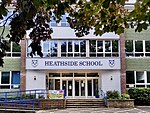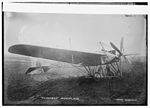Weybridge () is a town in the Borough of Elmbridge in Surrey, England, around 17 mi (27 km) southwest of central London. The settlement is recorded as Waigebrugge and Weibrugge in the 7th century and the name derives from a crossing point of the River Wey, which flows into the River Thames to the north of the town centre. The earliest evidence of human activity is from the Bronze Age. During the Anglo-Saxon and medieval periods, Weybridge was held by Chertsey Abbey.
In the 1530s, Henry VIII constructed Oatlands Palace to the north of the town centre, which he intended to be the residence of his fourth wife, Anne of Cleves. He married Catherine Howard there in July 1540 and the palace remained a royal residence until the Civil War. The buildings were demolished in the early 1650s and a new mansion, Oatlands House, was constructed to the east of Weybridge later the same century. Prince Frederick, Duke of York and Albany owned the mansion in the 18th century.
The town began to expand beyond its medieval footprint in the early 19th century, catalysed by the initial breakup of the Oatlands House estate, the enclosure of Weybridge Heath and the opening of the railway station in 1838. The developer, W. G. Tarrant, was responsible for the construction of housing on St George's Hill in the first half of the 20th century.
The world's first purpose-built racing circuit was constructed at Brooklands in 1907. The track hosted the first British Grand Prix in 1926 and was used by Malcolm Campbell to develop his final land speed record car, Campbell-Railton Blue Bird. Throughout the 20th century, Brooklands was an important location for the aerospace industry and aircraft developed and tested there included the Sopwith Camel, the Wellington bomber and the Hurricane fighter. Vickers established a factory at the circuit in 1915 and aircraft manufacturing continued at the site until 1988.










